Intranet: Staged Methodology and Implementation Report
VerifiedAdded on 2020/05/28
|10
|2129
|171
Report
AI Summary
This report provides a comprehensive analysis of intranet development and implementation strategies. It begins by defining the intranet and its benefits, highlighting its role in streamlining internal communications and boosting productivity across various business sizes. The report then details a staged methodology for intranet implementation, outlining eight crucial stages from defining business context to establishing a strategy and roadmap. The report also explores the concept of critical mass in terms of users, content, and utilization, emphasizing the importance of a robust intranet search engine. Furthermore, it discusses procedures to enhance web content, including improving common query results, providing search suggestions, recognizing alternative terms, and handling misspellings. The report is well-researched, citing various academic sources to support its claims and provide a thorough understanding of intranet systems.
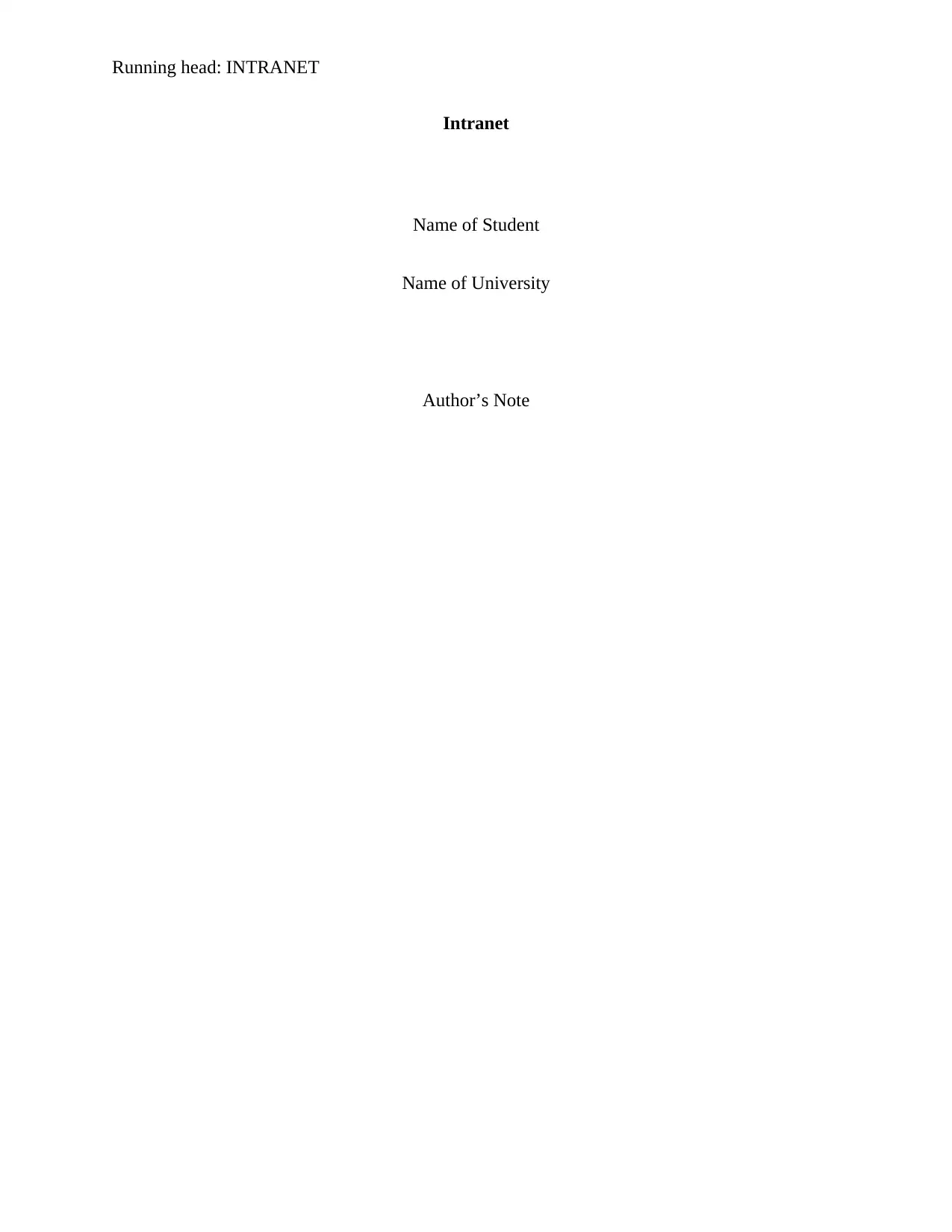
Running head: INTRANET
Intranet
Name of Student
Name of University
Author’s Note
Intranet
Name of Student
Name of University
Author’s Note
Paraphrase This Document
Need a fresh take? Get an instant paraphrase of this document with our AI Paraphraser
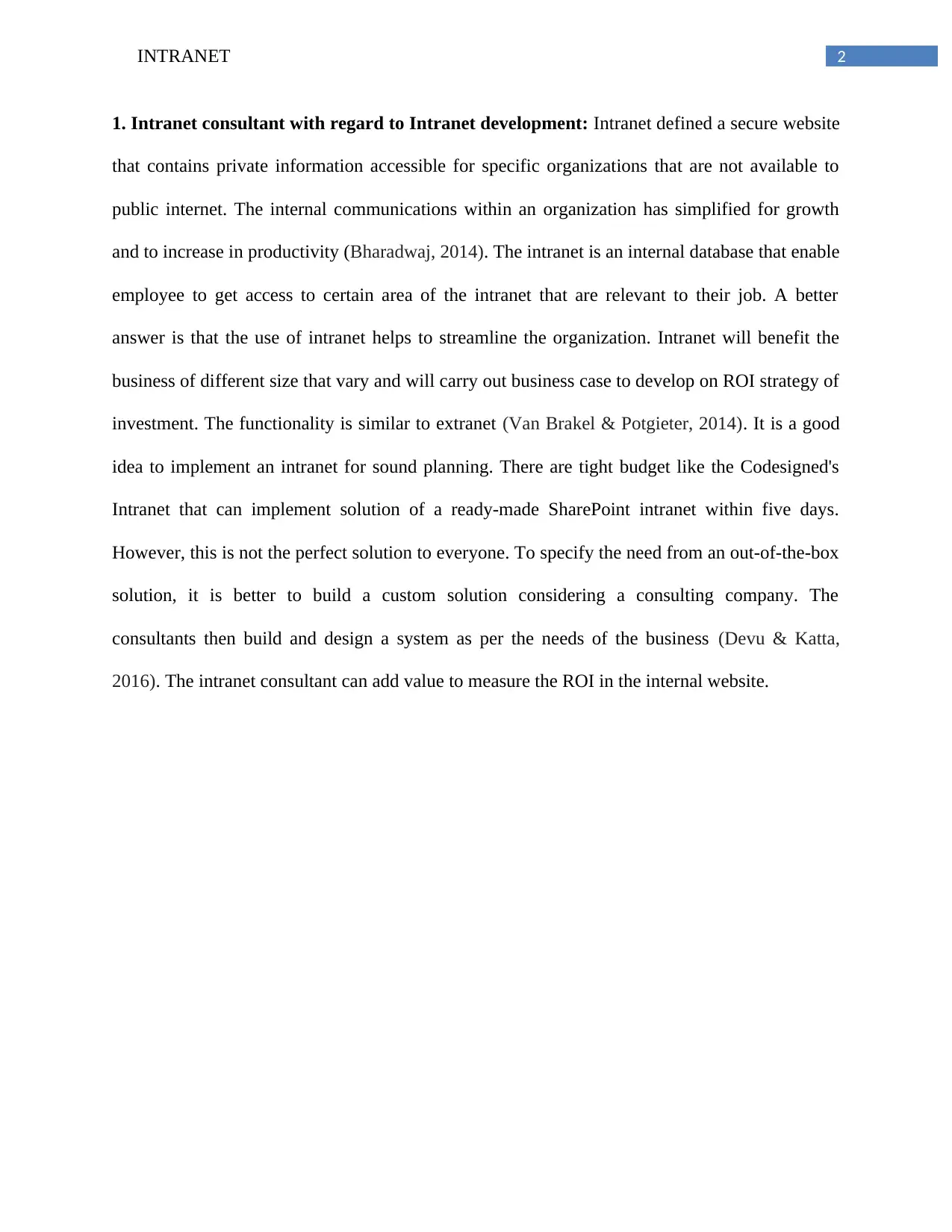
2INTRANET
1. Intranet consultant with regard to Intranet development: Intranet defined a secure website
that contains private information accessible for specific organizations that are not available to
public internet. The internal communications within an organization has simplified for growth
and to increase in productivity (Bharadwaj, 2014). The intranet is an internal database that enable
employee to get access to certain area of the intranet that are relevant to their job. A better
answer is that the use of intranet helps to streamline the organization. Intranet will benefit the
business of different size that vary and will carry out business case to develop on ROI strategy of
investment. The functionality is similar to extranet (Van Brakel & Potgieter, 2014). It is a good
idea to implement an intranet for sound planning. There are tight budget like the Codesigned's
Intranet that can implement solution of a ready-made SharePoint intranet within five days.
However, this is not the perfect solution to everyone. To specify the need from an out-of-the-box
solution, it is better to build a custom solution considering a consulting company. The
consultants then build and design a system as per the needs of the business (Devu & Katta,
2016). The intranet consultant can add value to measure the ROI in the internal website.
1. Intranet consultant with regard to Intranet development: Intranet defined a secure website
that contains private information accessible for specific organizations that are not available to
public internet. The internal communications within an organization has simplified for growth
and to increase in productivity (Bharadwaj, 2014). The intranet is an internal database that enable
employee to get access to certain area of the intranet that are relevant to their job. A better
answer is that the use of intranet helps to streamline the organization. Intranet will benefit the
business of different size that vary and will carry out business case to develop on ROI strategy of
investment. The functionality is similar to extranet (Van Brakel & Potgieter, 2014). It is a good
idea to implement an intranet for sound planning. There are tight budget like the Codesigned's
Intranet that can implement solution of a ready-made SharePoint intranet within five days.
However, this is not the perfect solution to everyone. To specify the need from an out-of-the-box
solution, it is better to build a custom solution considering a consulting company. The
consultants then build and design a system as per the needs of the business (Devu & Katta,
2016). The intranet consultant can add value to measure the ROI in the internal website.
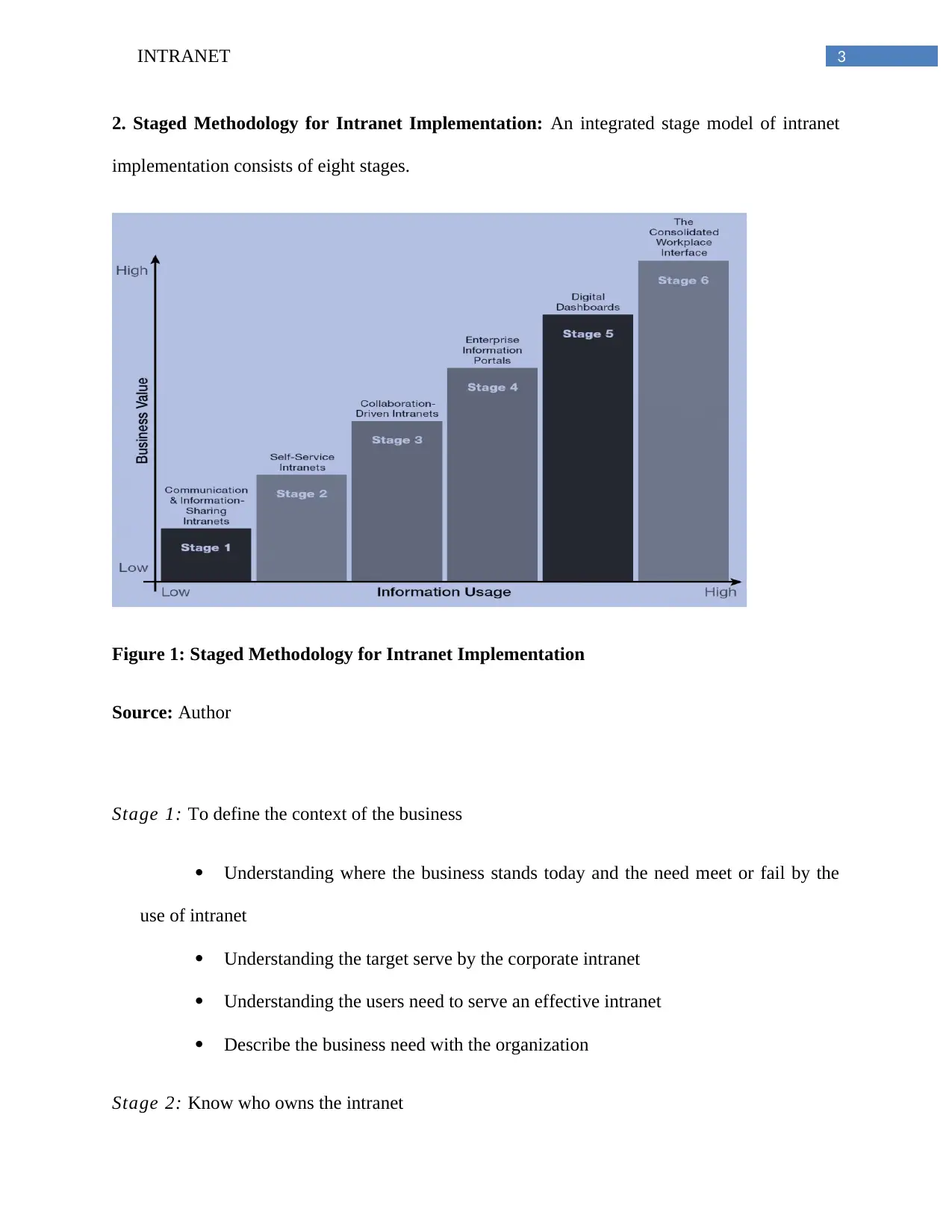
3INTRANET
2. Staged Methodology for Intranet Implementation: An integrated stage model of intranet
implementation consists of eight stages.
Figure 1: Staged Methodology for Intranet Implementation
Source: Author
Stage 1: To define the context of the business
Understanding where the business stands today and the need meet or fail by the
use of intranet
Understanding the target serve by the corporate intranet
Understanding the users need to serve an effective intranet
Describe the business need with the organization
Stage 2: Know who owns the intranet
2. Staged Methodology for Intranet Implementation: An integrated stage model of intranet
implementation consists of eight stages.
Figure 1: Staged Methodology for Intranet Implementation
Source: Author
Stage 1: To define the context of the business
Understanding where the business stands today and the need meet or fail by the
use of intranet
Understanding the target serve by the corporate intranet
Understanding the users need to serve an effective intranet
Describe the business need with the organization
Stage 2: Know who owns the intranet
⊘ This is a preview!⊘
Do you want full access?
Subscribe today to unlock all pages.

Trusted by 1+ million students worldwide
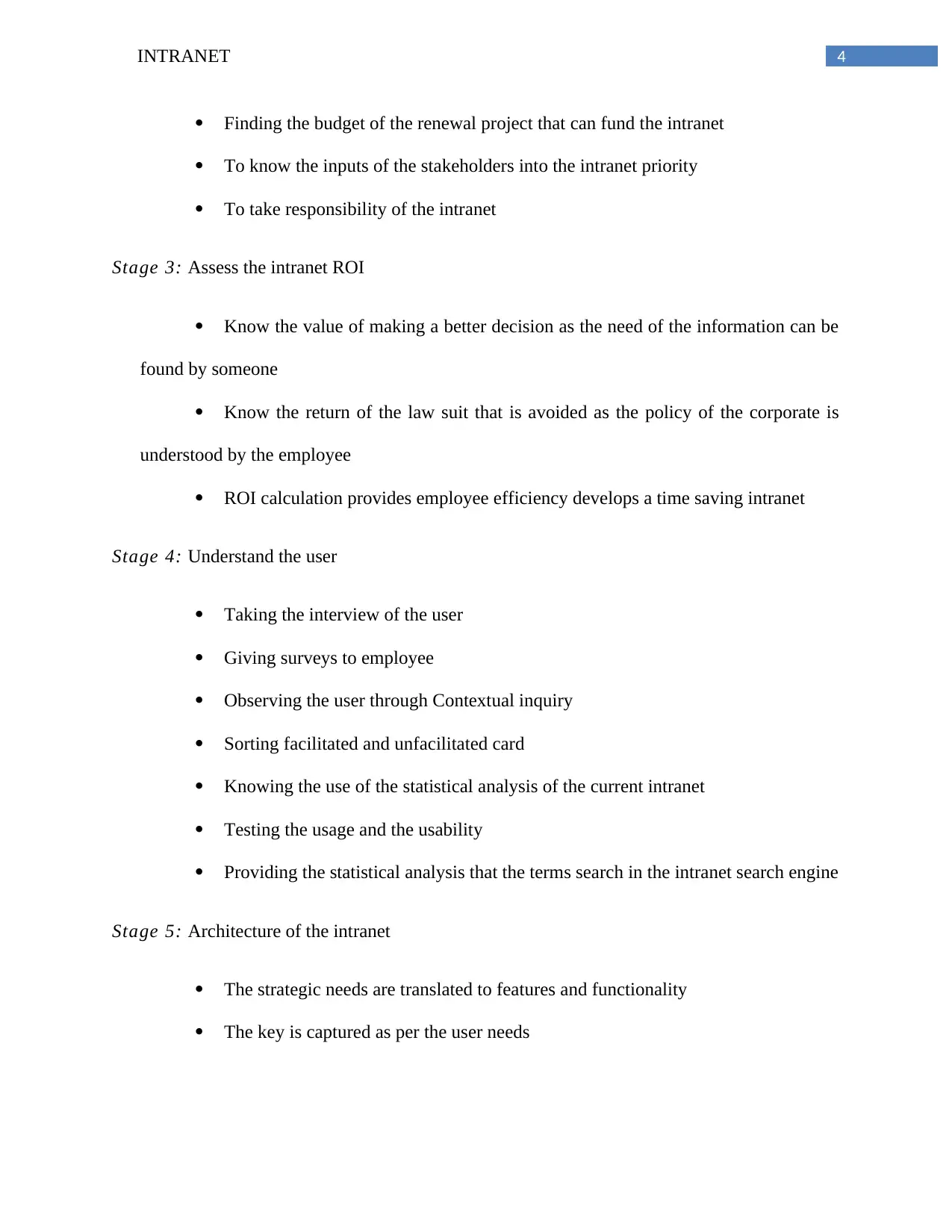
4INTRANET
Finding the budget of the renewal project that can fund the intranet
To know the inputs of the stakeholders into the intranet priority
To take responsibility of the intranet
Stage 3: Assess the intranet ROI
Know the value of making a better decision as the need of the information can be
found by someone
Know the return of the law suit that is avoided as the policy of the corporate is
understood by the employee
ROI calculation provides employee efficiency develops a time saving intranet
Stage 4: Understand the user
Taking the interview of the user
Giving surveys to employee
Observing the user through Contextual inquiry
Sorting facilitated and unfacilitated card
Knowing the use of the statistical analysis of the current intranet
Testing the usage and the usability
Providing the statistical analysis that the terms search in the intranet search engine
Stage 5: Architecture of the intranet
The strategic needs are translated to features and functionality
The key is captured as per the user needs
Finding the budget of the renewal project that can fund the intranet
To know the inputs of the stakeholders into the intranet priority
To take responsibility of the intranet
Stage 3: Assess the intranet ROI
Know the value of making a better decision as the need of the information can be
found by someone
Know the return of the law suit that is avoided as the policy of the corporate is
understood by the employee
ROI calculation provides employee efficiency develops a time saving intranet
Stage 4: Understand the user
Taking the interview of the user
Giving surveys to employee
Observing the user through Contextual inquiry
Sorting facilitated and unfacilitated card
Knowing the use of the statistical analysis of the current intranet
Testing the usage and the usability
Providing the statistical analysis that the terms search in the intranet search engine
Stage 5: Architecture of the intranet
The strategic needs are translated to features and functionality
The key is captured as per the user needs
Paraphrase This Document
Need a fresh take? Get an instant paraphrase of this document with our AI Paraphraser
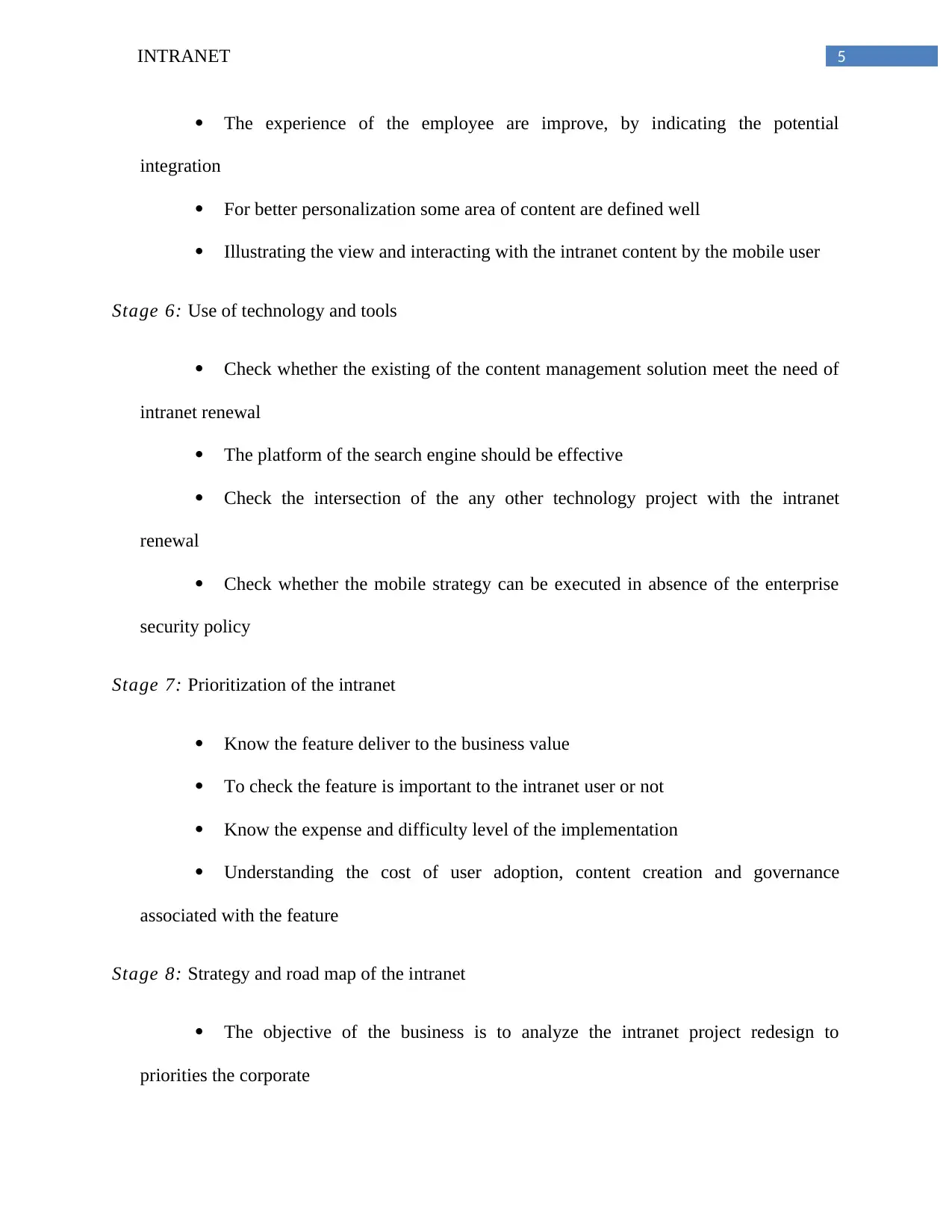
5INTRANET
The experience of the employee are improve, by indicating the potential
integration
For better personalization some area of content are defined well
Illustrating the view and interacting with the intranet content by the mobile user
Stage 6: Use of technology and tools
Check whether the existing of the content management solution meet the need of
intranet renewal
The platform of the search engine should be effective
Check the intersection of the any other technology project with the intranet
renewal
Check whether the mobile strategy can be executed in absence of the enterprise
security policy
Stage 7: Prioritization of the intranet
Know the feature deliver to the business value
To check the feature is important to the intranet user or not
Know the expense and difficulty level of the implementation
Understanding the cost of user adoption, content creation and governance
associated with the feature
Stage 8: Strategy and road map of the intranet
The objective of the business is to analyze the intranet project redesign to
priorities the corporate
The experience of the employee are improve, by indicating the potential
integration
For better personalization some area of content are defined well
Illustrating the view and interacting with the intranet content by the mobile user
Stage 6: Use of technology and tools
Check whether the existing of the content management solution meet the need of
intranet renewal
The platform of the search engine should be effective
Check the intersection of the any other technology project with the intranet
renewal
Check whether the mobile strategy can be executed in absence of the enterprise
security policy
Stage 7: Prioritization of the intranet
Know the feature deliver to the business value
To check the feature is important to the intranet user or not
Know the expense and difficulty level of the implementation
Understanding the cost of user adoption, content creation and governance
associated with the feature
Stage 8: Strategy and road map of the intranet
The objective of the business is to analyze the intranet project redesign to
priorities the corporate

6INTRANET
The road map of the intranet visually depicts the prioritization outcomes to put
timeline on the intranet redesign project
Aspirational wireframe deliver the value of the business through project
3. Purported critical mass in the area of users, content, and utilization: The user uses the
intranet in a specific organization to access the private information. In a business technology,
critical mass is the platform for business users to adopt an innovative system for self-
reinforcement (Chin et al., 2015). It refers to the company size to meet the efficiency and
competitiveness of the market. To the user the resources have centralized with the knowledge
and information for the growth of the business. Intranet as a critical mass provides a platform for
the staff of online community (Hu, Kettinger & Poston, 2015). Intranet offers features to
improve the commercial search engine manually so the user can manually search the content
with related terms. The user gets a wider knowledge about the management strategy. A strong
foundation has built to support the creation, capture and distribution of information. In the area
of content, the critical mass is required when the content is not available or the search engine
could not provide a proper search type based on the content. When content have a lot of complex
jargon in that case spelling suggestions are the key to help the users to find what they need. The
utilization of the intranet for the long-term success will provide benefits to the business as a
whole. The communication channel is more effective between the user to utilize the content and
search in the intranet search engine (Khodakarami & Chan, 2014). Businesses always have a
goal to relate the strategic project widely to the user to search for information to get knowledge
of the project.
The road map of the intranet visually depicts the prioritization outcomes to put
timeline on the intranet redesign project
Aspirational wireframe deliver the value of the business through project
3. Purported critical mass in the area of users, content, and utilization: The user uses the
intranet in a specific organization to access the private information. In a business technology,
critical mass is the platform for business users to adopt an innovative system for self-
reinforcement (Chin et al., 2015). It refers to the company size to meet the efficiency and
competitiveness of the market. To the user the resources have centralized with the knowledge
and information for the growth of the business. Intranet as a critical mass provides a platform for
the staff of online community (Hu, Kettinger & Poston, 2015). Intranet offers features to
improve the commercial search engine manually so the user can manually search the content
with related terms. The user gets a wider knowledge about the management strategy. A strong
foundation has built to support the creation, capture and distribution of information. In the area
of content, the critical mass is required when the content is not available or the search engine
could not provide a proper search type based on the content. When content have a lot of complex
jargon in that case spelling suggestions are the key to help the users to find what they need. The
utilization of the intranet for the long-term success will provide benefits to the business as a
whole. The communication channel is more effective between the user to utilize the content and
search in the intranet search engine (Khodakarami & Chan, 2014). Businesses always have a
goal to relate the strategic project widely to the user to search for information to get knowledge
of the project.
⊘ This is a preview!⊘
Do you want full access?
Subscribe today to unlock all pages.

Trusted by 1+ million students worldwide
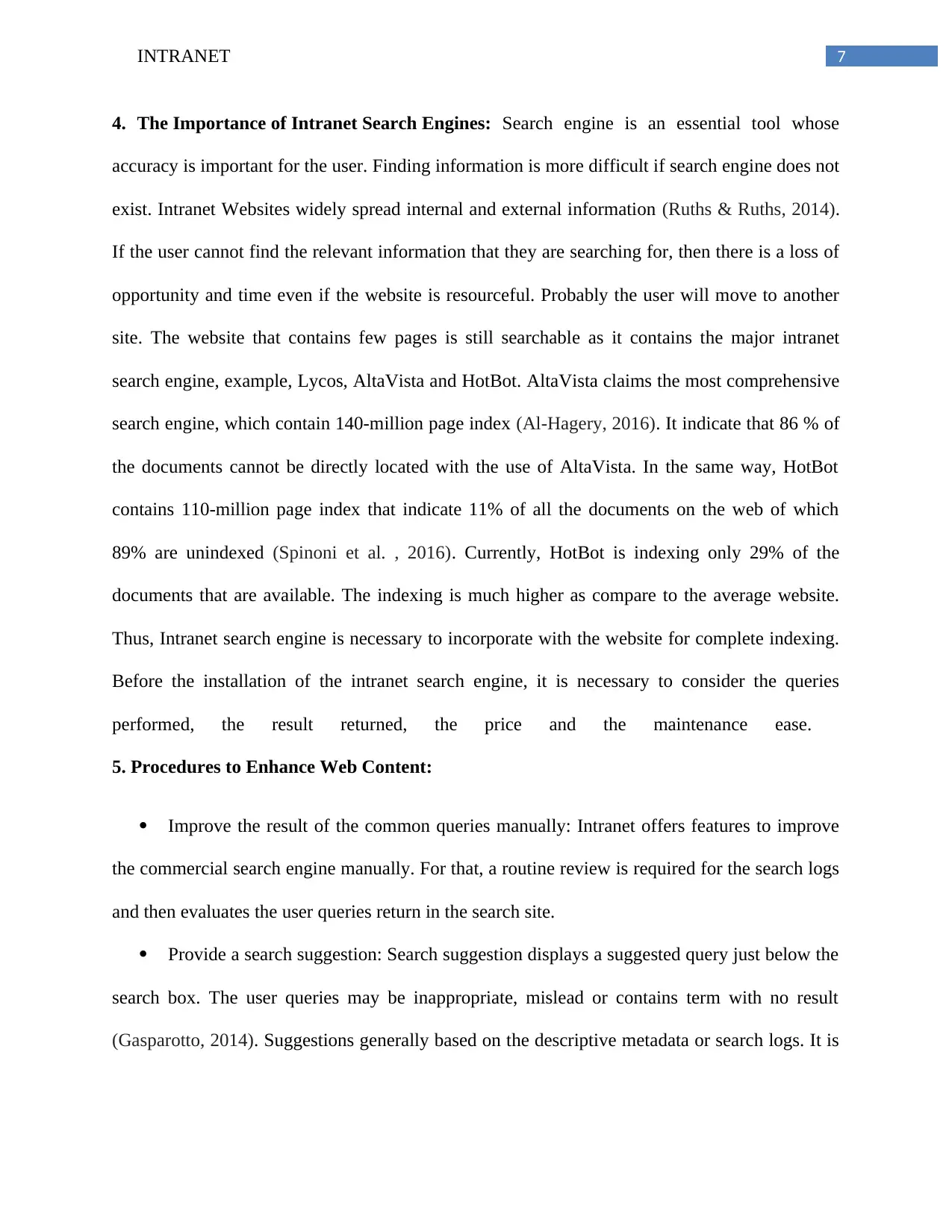
7INTRANET
4. The Importance of Intranet Search Engines: Search engine is an essential tool whose
accuracy is important for the user. Finding information is more difficult if search engine does not
exist. Intranet Websites widely spread internal and external information (Ruths & Ruths, 2014).
If the user cannot find the relevant information that they are searching for, then there is a loss of
opportunity and time even if the website is resourceful. Probably the user will move to another
site. The website that contains few pages is still searchable as it contains the major intranet
search engine, example, Lycos, AltaVista and HotBot. AltaVista claims the most comprehensive
search engine, which contain 140-million page index (Al-Hagery, 2016). It indicate that 86 % of
the documents cannot be directly located with the use of AltaVista. In the same way, HotBot
contains 110-million page index that indicate 11% of all the documents on the web of which
89% are unindexed (Spinoni et al. , 2016). Currently, HotBot is indexing only 29% of the
documents that are available. The indexing is much higher as compare to the average website.
Thus, Intranet search engine is necessary to incorporate with the website for complete indexing.
Before the installation of the intranet search engine, it is necessary to consider the queries
performed, the result returned, the price and the maintenance ease.
5. Procedures to Enhance Web Content:
Improve the result of the common queries manually: Intranet offers features to improve
the commercial search engine manually. For that, a routine review is required for the search logs
and then evaluates the user queries return in the search site.
Provide a search suggestion: Search suggestion displays a suggested query just below the
search box. The user queries may be inappropriate, mislead or contains term with no result
(Gasparotto, 2014). Suggestions generally based on the descriptive metadata or search logs. It is
4. The Importance of Intranet Search Engines: Search engine is an essential tool whose
accuracy is important for the user. Finding information is more difficult if search engine does not
exist. Intranet Websites widely spread internal and external information (Ruths & Ruths, 2014).
If the user cannot find the relevant information that they are searching for, then there is a loss of
opportunity and time even if the website is resourceful. Probably the user will move to another
site. The website that contains few pages is still searchable as it contains the major intranet
search engine, example, Lycos, AltaVista and HotBot. AltaVista claims the most comprehensive
search engine, which contain 140-million page index (Al-Hagery, 2016). It indicate that 86 % of
the documents cannot be directly located with the use of AltaVista. In the same way, HotBot
contains 110-million page index that indicate 11% of all the documents on the web of which
89% are unindexed (Spinoni et al. , 2016). Currently, HotBot is indexing only 29% of the
documents that are available. The indexing is much higher as compare to the average website.
Thus, Intranet search engine is necessary to incorporate with the website for complete indexing.
Before the installation of the intranet search engine, it is necessary to consider the queries
performed, the result returned, the price and the maintenance ease.
5. Procedures to Enhance Web Content:
Improve the result of the common queries manually: Intranet offers features to improve
the commercial search engine manually. For that, a routine review is required for the search logs
and then evaluates the user queries return in the search site.
Provide a search suggestion: Search suggestion displays a suggested query just below the
search box. The user queries may be inappropriate, mislead or contains term with no result
(Gasparotto, 2014). Suggestions generally based on the descriptive metadata or search logs. It is
Paraphrase This Document
Need a fresh take? Get an instant paraphrase of this document with our AI Paraphraser

8INTRANET
critical to highlight the terms of the suggested query, which usually match with the input query.
For example, while the user type; the word seems to appear in between the suggested query.
Recognize the alternative terms and the synonyms: User generally has no idea of
formulating a perfect query nor they know the industry jargon or appropriate phrases. Sometime,
user does not know what to search and just type a vague search terms. It is important to
accommodate a realistic synonym and alternative terms whose content is industry specific,
technical or jargon heavy (Konys, 2015). The user must know about the crafted lingo that
everyone uses in office on daily basis. To create a synonyms table for the user search engine, it is
better to review the search log and look for synonyms to get appropriate results.
Handle the misspelling: When content have a lot of complex jargon in that case spelling
suggestions are the key to help the users to find what they need. Query suggestions will adjust
the spelling errors while the user is typing the query (Mitra et al., 2014). Misspellings and typos
have a form of Did you mean for the spelling correction. If there is no results in the original
query, then the user need not required to click on the Did you mean link. The user just needs to
be sure that the result is retrieved from the variation of the user’s spelling.
critical to highlight the terms of the suggested query, which usually match with the input query.
For example, while the user type; the word seems to appear in between the suggested query.
Recognize the alternative terms and the synonyms: User generally has no idea of
formulating a perfect query nor they know the industry jargon or appropriate phrases. Sometime,
user does not know what to search and just type a vague search terms. It is important to
accommodate a realistic synonym and alternative terms whose content is industry specific,
technical or jargon heavy (Konys, 2015). The user must know about the crafted lingo that
everyone uses in office on daily basis. To create a synonyms table for the user search engine, it is
better to review the search log and look for synonyms to get appropriate results.
Handle the misspelling: When content have a lot of complex jargon in that case spelling
suggestions are the key to help the users to find what they need. Query suggestions will adjust
the spelling errors while the user is typing the query (Mitra et al., 2014). Misspellings and typos
have a form of Did you mean for the spelling correction. If there is no results in the original
query, then the user need not required to click on the Did you mean link. The user just needs to
be sure that the result is retrieved from the variation of the user’s spelling.
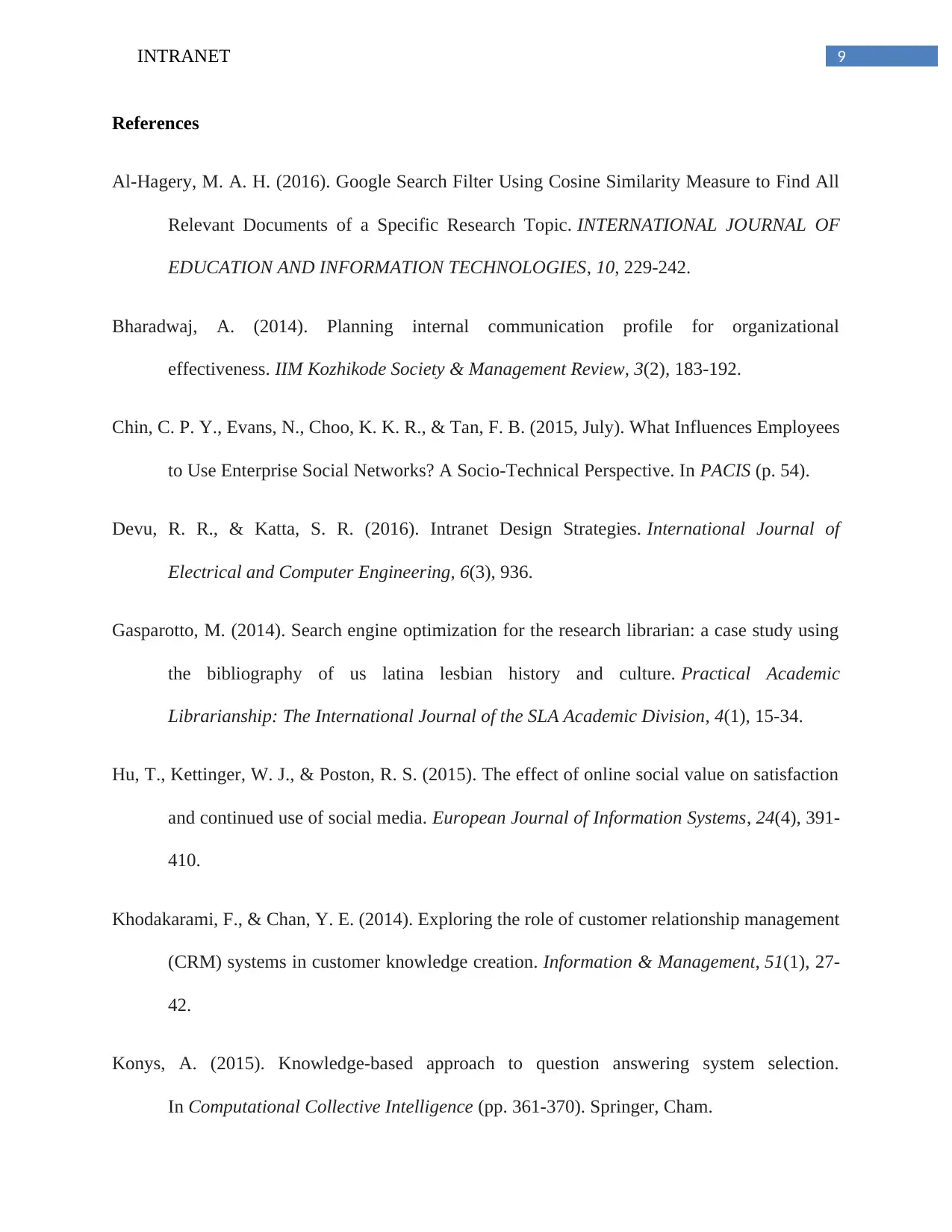
9INTRANET
References
Al-Hagery, M. A. H. (2016). Google Search Filter Using Cosine Similarity Measure to Find All
Relevant Documents of a Specific Research Topic. INTERNATIONAL JOURNAL OF
EDUCATION AND INFORMATION TECHNOLOGIES, 10, 229-242.
Bharadwaj, A. (2014). Planning internal communication profile for organizational
effectiveness. IIM Kozhikode Society & Management Review, 3(2), 183-192.
Chin, C. P. Y., Evans, N., Choo, K. K. R., & Tan, F. B. (2015, July). What Influences Employees
to Use Enterprise Social Networks? A Socio-Technical Perspective. In PACIS (p. 54).
Devu, R. R., & Katta, S. R. (2016). Intranet Design Strategies. International Journal of
Electrical and Computer Engineering, 6(3), 936.
Gasparotto, M. (2014). Search engine optimization for the research librarian: a case study using
the bibliography of us latina lesbian history and culture. Practical Academic
Librarianship: The International Journal of the SLA Academic Division, 4(1), 15-34.
Hu, T., Kettinger, W. J., & Poston, R. S. (2015). The effect of online social value on satisfaction
and continued use of social media. European Journal of Information Systems, 24(4), 391-
410.
Khodakarami, F., & Chan, Y. E. (2014). Exploring the role of customer relationship management
(CRM) systems in customer knowledge creation. Information & Management, 51(1), 27-
42.
Konys, A. (2015). Knowledge-based approach to question answering system selection.
In Computational Collective Intelligence (pp. 361-370). Springer, Cham.
References
Al-Hagery, M. A. H. (2016). Google Search Filter Using Cosine Similarity Measure to Find All
Relevant Documents of a Specific Research Topic. INTERNATIONAL JOURNAL OF
EDUCATION AND INFORMATION TECHNOLOGIES, 10, 229-242.
Bharadwaj, A. (2014). Planning internal communication profile for organizational
effectiveness. IIM Kozhikode Society & Management Review, 3(2), 183-192.
Chin, C. P. Y., Evans, N., Choo, K. K. R., & Tan, F. B. (2015, July). What Influences Employees
to Use Enterprise Social Networks? A Socio-Technical Perspective. In PACIS (p. 54).
Devu, R. R., & Katta, S. R. (2016). Intranet Design Strategies. International Journal of
Electrical and Computer Engineering, 6(3), 936.
Gasparotto, M. (2014). Search engine optimization for the research librarian: a case study using
the bibliography of us latina lesbian history and culture. Practical Academic
Librarianship: The International Journal of the SLA Academic Division, 4(1), 15-34.
Hu, T., Kettinger, W. J., & Poston, R. S. (2015). The effect of online social value on satisfaction
and continued use of social media. European Journal of Information Systems, 24(4), 391-
410.
Khodakarami, F., & Chan, Y. E. (2014). Exploring the role of customer relationship management
(CRM) systems in customer knowledge creation. Information & Management, 51(1), 27-
42.
Konys, A. (2015). Knowledge-based approach to question answering system selection.
In Computational Collective Intelligence (pp. 361-370). Springer, Cham.
⊘ This is a preview!⊘
Do you want full access?
Subscribe today to unlock all pages.

Trusted by 1+ million students worldwide
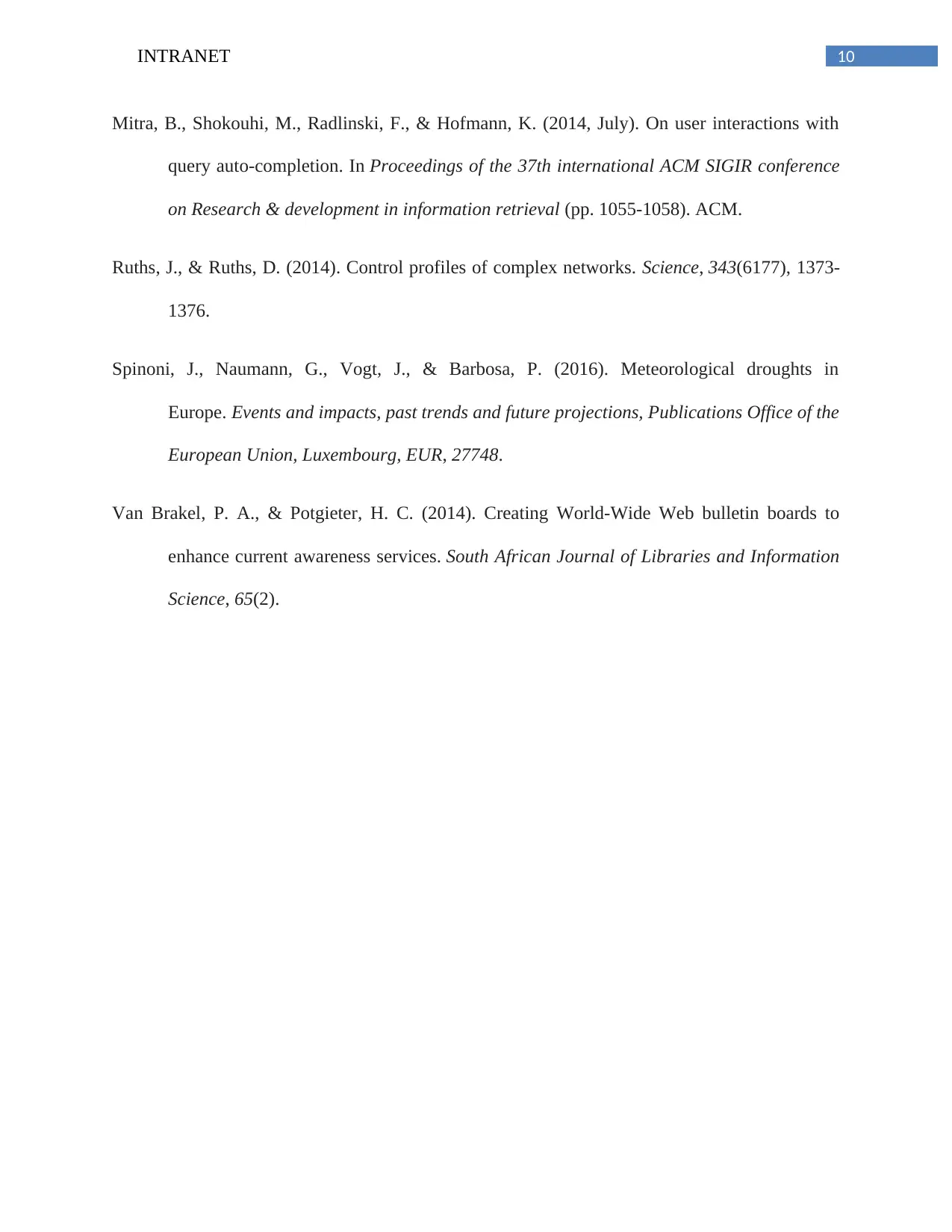
10INTRANET
Mitra, B., Shokouhi, M., Radlinski, F., & Hofmann, K. (2014, July). On user interactions with
query auto-completion. In Proceedings of the 37th international ACM SIGIR conference
on Research & development in information retrieval (pp. 1055-1058). ACM.
Ruths, J., & Ruths, D. (2014). Control profiles of complex networks. Science, 343(6177), 1373-
1376.
Spinoni, J., Naumann, G., Vogt, J., & Barbosa, P. (2016). Meteorological droughts in
Europe. Events and impacts, past trends and future projections, Publications Office of the
European Union, Luxembourg, EUR, 27748.
Van Brakel, P. A., & Potgieter, H. C. (2014). Creating World-Wide Web bulletin boards to
enhance current awareness services. South African Journal of Libraries and Information
Science, 65(2).
Mitra, B., Shokouhi, M., Radlinski, F., & Hofmann, K. (2014, July). On user interactions with
query auto-completion. In Proceedings of the 37th international ACM SIGIR conference
on Research & development in information retrieval (pp. 1055-1058). ACM.
Ruths, J., & Ruths, D. (2014). Control profiles of complex networks. Science, 343(6177), 1373-
1376.
Spinoni, J., Naumann, G., Vogt, J., & Barbosa, P. (2016). Meteorological droughts in
Europe. Events and impacts, past trends and future projections, Publications Office of the
European Union, Luxembourg, EUR, 27748.
Van Brakel, P. A., & Potgieter, H. C. (2014). Creating World-Wide Web bulletin boards to
enhance current awareness services. South African Journal of Libraries and Information
Science, 65(2).
1 out of 10
Related Documents
Your All-in-One AI-Powered Toolkit for Academic Success.
+13062052269
info@desklib.com
Available 24*7 on WhatsApp / Email
![[object Object]](/_next/static/media/star-bottom.7253800d.svg)
Unlock your academic potential
Copyright © 2020–2025 A2Z Services. All Rights Reserved. Developed and managed by ZUCOL.





